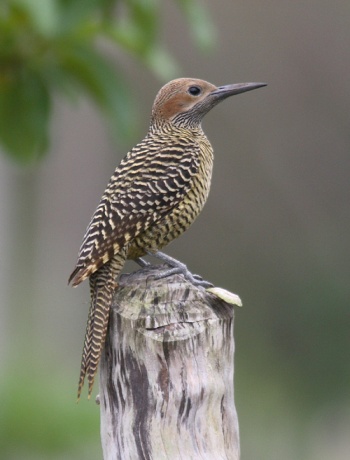Alternative name: Cuban Flicker
- Colaptes fernandinae
Identification
30cm
- Brownish-black above (including wings) with yellow bars
- Yellow underparts, with brownish-black barring
- Coppery tinged head
- Yellow ear coverts
- Bill is long and de-curved
- Malar stripe is black in male but mottled in the female
Distribution
Endemic to Cuba (rare and local).
A localized species, with only a few hundred pairs in existence.
Taxonomy
Habitat
Lowland palm groves, limestone open woodland.
Behaviour
Diet
Forages mostly on the ground amongst the leaf litter for insects, larvae and sometimes seeds.
Breeding
They use a hole in a palm tree for nesting, often one formed by another species.
References
- Clements, J. F., T. S. Schulenberg, M. J. Iliff, B.L. Sullivan, C. L. Wood, and D. Roberson. 2012. The eBird/Clements Checklist of Birds of the World. 6th ed., with updates to October 2012. Ithaca: Cornell Univ. Press. ISBN 978-0801445019. Spreadsheet available at http://www.birds.cornell.edu/clementschecklist/downloadable-clements-checklist
- BirdLife International
- Arthur Grosset
- Wikipedia
Recommended Citation
- BirdForum Opus contributors. (2025) Fernandina's Flicker. In: BirdForum, the forum for wild birds and birding. Retrieved 9 May 2025 from https://www.birdforum.net/opus/Fernandina%27s_Flicker
External Links
GSearch checked for 2020 platform.





